
![]()
![]()
1995 NSF Annual ReportYEAR-ONE
DEB-9505031, $222,842, 15 August 1995--31 July 1996 BIODIVERSITY OF THE KURIL ARCHIPELAGO |
| Goals.--Following on our 1994 "proof of concept" award, with which we successfully collected on four of the southern Kuril Islands (Kunashir, Iturup, Zelionyi, and Shikotan), the primary goal of this first of five expeditions to the Kuril Archipelago was to continue our survey northward to seven islands that make up the central part of the chain: Urup, Chirpoi, Broutona, Simushir, Ketoi, Ushishir, and Rasshua. We also planned to return to a number of previously under-collected localities on southern islands visited in 1994, i.e., Iturup, but especially Kunashir. We also determined to expand our collecting overall to include vascular plants, aquatic as well as terrestrial insects, spiders, freshwater and terrestrial mollusks, fishes, and terrestrial vertebrates (see Island Info). In every way these goals have been met. |
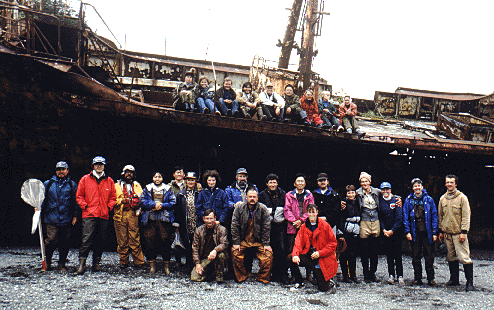 1995 IKIP participants in the field at Negodnaya Bay, Urup Island |
Results to date.--An international team of 30 students and scientists--14 on the Russian Team, 6 on the Japanese Team, and 10 on the American Team--met in Hakodate, Hokkaido, Japan, on 27 July 1995, boarded the 68.8-m Professor Bogorov, a research vessel of the Russian Academy of Sciences, and spent 42 days in the field. Seven islands of the central Kurils and two from the southern group were visited. Collections were made at 1,170 sites (see IKIP Databases)--more than twice the number collected in 1994: 516 on Urup, 50 on Chirpoi, 10 on Broutona, 176 on Simushir, 104 on Ketoi, 74 on Ushishir, 85 on Rasshua, 86 on Kunashir, and 69 on Iturup--in widely varying habitats, similar to those collected in 1994 (see Macro- and microhabitats of the Kuril Islands): from sea-level sandy-, rocky-beach, and grassland to high-mountain stream/conifer forest; from deep, slow-moving lowland rivers to fast-flowing gravelly streams; and from sphagnum bogs to high mountain lakes. Collecting was confined primarily to plants (vascular as well as lichens and mosses), aquatic and terrestrial insects, spiders, freshwater and terrestrial mollusks, freshwater and anadromous fishes, amphibians, reptiles, and terrestrial mammals (smaller collections of platyhelminths, oligochaetes, amphipods, centipedes, millipedes, marine fishes, and marine mammals were also made). While certain uncontrollable difficulties inherent in the project repeated themselves this year (such as impenetrable vegetation making adherence to transects impossible and difficult shore landings at some sites), the problems we experienced in 1994 of gaining access to certain islands and to sites within islands did not reoccur. Our research vessel, the Professor Bogorov (which also served as our base of operations in 1994), ably managed by its Russian crew of 30, performed well, although at times we wished for more space (see Russian Research Vessels). Research products.--Although counts are still preliminary (and despite the considerably less diverse biotas of the central islands), approximately 45,080 specimens were successfully exported to the U.S.: Plants: 2,500 specimens, representing 67 families and 369 species, three of which appear to be new (at least at the subspecific level); the material represents at least 54 new records for various islands, and one new record for the Archipelago. Aquatic insects: 12,014 specimens, representing 33 families and a minimum of 153 species, of which one is thought to be new to science; 116 new records for various islands and 32 new records for the Archipelago. Terrestrial insects: about 15,850 specimens, representing about 90 families and perhaps as many as 650 species; the material undoubtedly includes new taxa and many new records, but less than half the collection has been sorted to species and much is not yet even sorted to family. Spiders: 5,530 specimens, representing 21 families and 205 species, of which at least 15 are thought to be new to science; 342 new records for various islands, and two families, eight genera, and 15 species new to the Archipelago (but much of the material remains to be sorted and identified, and much that is sorted is identified only to genus). Mollusks: 5,059 specimens, 19 families, and at least 24 species, of which 1 is new to science; 23 new records for various islands and 3 new records for the Archipelago. Freshwater fishes: 3,992 specimens, 11 species, and five families. Amphibians and reptiles: 38 specimens, three species, and three families. Terrestrial mammals: 108 specimens, two species.
|
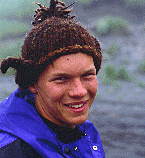
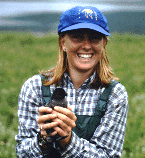 Students Pontus Oberg and Danielle (Hopi) Hoekstra (both UW) |
Human resource development.--Two UW undergraduates, Pontus Oberg (insects) and Suzanne Lindsay (mollusks) (both supported by REU funds, see below), and three UW graduate students, Noboru Minakawa (insects), Andres Lopez (fishes), and Danielle (Hopi) Hoekstra, all full participants in the 1995 expedition, received training in field work, curatorial practices, and systematics within their areas of interest. Their experience continues here at home as collections are being sorted and identified, and publications prepared.
Seminars, media attention, and publications.--We have made a concerted effort to inform others about IKIP through oral presentation, to academic as well as public audiences, and have received considerable attention from the media in return. A few "sound bites" of some of the more exciting discoveries to date, which have caught the attention of the media and the public include:
"Bogs pockmarked with pools of water barely two feet across but plunging a number of unsuspecting scientists in over their heads. Scientists still aren't sure how deep the pools are because they couldn't touch the bottoms even when they knelt by the edges and reached down as far as they could with their eight-foot-long dip nets. Scientists are puzzling over the fishes found in every pool they sampled: How did the fishes get there? Are the individual "wells" connected underground?" |
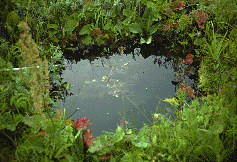
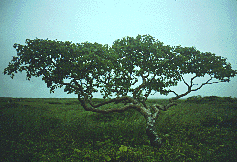 Small bog near Lake Sredneye; a lone tree (both Zelionyi Island) |
"One small island, only five miles across, supports grasslands, large lakes, and two trees: There used to be five trees, Pietsch was told, but a tsunami 15 years ago swept across the entire island and carried three of the trees into the sea." |
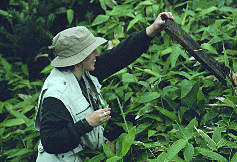
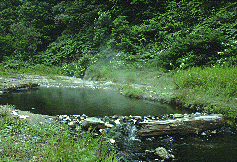 Collecting in a bamboo thicket (Iturup Island); Unnamed hot springs (Kunashir Island) |
"An island with pools and streams of 41ºC (106ºF) water, fed by volcanic hot springs and inhabited by tiny fishes called gobies." This is probably our single most interesting finding to date: a tiny, isolated ecosystem of thick mats of bacteria, aquatic insects, and gobies, at the bottom of a deep valley on Kunashir, driven by, and maintained long-term through the severe cold of winter by hot water. We plan to return to this site during future expeditions to study its ecology; it would be especially interesting to visit this site during mid-winter, when we imagine the hot pools surrounded by three-meter "cliffs" of snow and ice.
|
![]()
 The plants, insects,
spiders, and freshwater fishes are presently being identified and cataloged
here in the Department of Botany and Burke Museum, University of Washington;
the mollusks are being processed in
The plants, insects,
spiders, and freshwater fishes are presently being identified and cataloged
here in the Department of Botany and Burke Museum, University of Washington;
the mollusks are being processed in